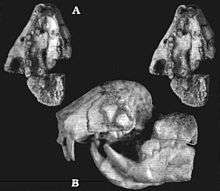Kryptobaatar
| Kryptobaatar Temporal range: Campanian-Maastrichtian | |
|---|---|
 | |
| Kryptobataar mandahuensis | |
| Scientific classification | |
| Kingdom: | Animalia |
| Phylum: | Chordata |
| Class: | Mammalia |
| Order: | Multituberculata |
| Family: | Djadochtatheriidae |
| Genus: | Kryptobaatar |
| Species | |
| |
Kryptobaatar[1] ("hidden hero," from Greek: kryptos, "hidden," and Mongolian: baatar, "hero" or "athlete") and also known as Gobiaatar, Gobibaatar ("Gobi hero")[1] or Tugrigbaatar[2] is an extinct mammalian genus dating from the Upper Cretaceous Period and identified in Central Asia. This animal was a member of the extinct order of Multituberculata within the suborder Cimolodonta, and was a member of the family Djadochtatheriidae. It lived contemporaneously with some of the dinosaurs. Its skull had a length of perhaps 3 cm.
Species identified

- Kryptobaatar dashzevegi (Kielan-Jaworowska Z, 1970). At Djadokhta Formation, Ukhaa Tolgod and Tögrög Shiree, Mongolia. Age: lower Campanian or Upper Cretaceous. The skull has a length of perhaps 3 cm. The front teeth look impressively sharp and not much like those of a strict vegetarian.
- Kryptobaatar gobiensis, also known as Gobibaatar parvus (Kielan-Jaworowska Z, 1970), from the Maastrichtian, from the Gobi Desert, Mongolia.
- Kryptobaatar mandahuensis Smith T, Guo D-Y & Sun Y, 2001. It is from the Campanian (Upper Cretaceous) strata of the Bayan Mandahu red beds, Inner Mongolia, China. Based on several well-preserved skulls. This location is about the same age as the Djadokhta Formation of Mongolia.
- Kryptobaatar saichanensis (Kielan-Jaworowska Z & Dashzeveg D, 1978), also known as Tugrigbaatar saichanensis (Kielan-Jaworowska Z & Dashzeveg D. 1978) from the Maastrichtian of Mongolia.
Biology
Kryptobaatar was a hopping species, similar to a modern gerboa.[3]
Notes
- 1 2 Kielan-Jaworowska Z, 1970
- ↑ Kielan-Jaworowska Z & Dashzeveg D, 1978. "Gobibaatar has page priority but was selected as the junior synonym by Kielan-Jaworowska in 1980," (McKenna & Bell, 1997)
- ↑ Meng Chen, Gregory Philip Wilson, A multivariate approach to infer locomotor modes in Mesozoic mammals, Article in Paleobiology 41(02) · February 2015 DOI: 10.1017/pab.2014.14
References
- Kielan-Jaworowska Z & Hurum JH (2001), "Phylogeny and Systematics of multituberculate mammals". Paleontology 44, p.389-429.
- McKenna MC & Bell SK, (1997), Classification of Mammals Above the Species Level. Columbia University Press.
- Kielan-Jaworowska (1970), New Upper Cretaceous multituberculate genera from Bayn Dzak, Gobi Desert. In: Kielan-Jaworowska (ed.), Results of the Polish-Mongolian Palaeontological Expeditions, pt. II. Palaeontologica Polonica 21, p.35-49.
See also
WIBLE, JOHN R.; ROUGIER, GUILLERMO W. (February 2000). "Cranial anatomy of Kryptobaatar dashzevegi (Mammalia, Multituberculata), and its bearing on the evolution of mammalian characters". Bulletin of the American Museum of Natural History. 247: 1–120. doi:10.1206/0003-0090(2000)247<0001:CAOKDM>2.0.CO;2.